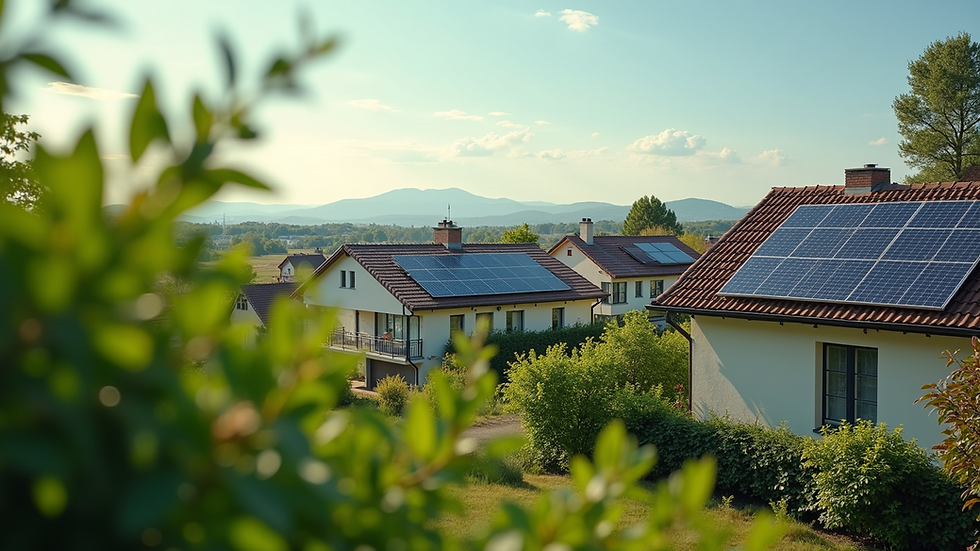Creating a Sustainable Community: The Ultimate Guide
- farrakhan Muhammad
- Oct 7
- 4 min read
Building a sustainable community is more than just a trend - it is a necessary step toward ensuring a healthy environment, strong social bonds, and economic resilience. This guide will walk you through the essential sustainable community principles and practical steps to create a thriving, eco-friendly neighborhood. Whether you are starting from scratch or improving an existing area, these insights will help you foster a community that lasts for generations.
Understanding Sustainable Community Principles
Sustainable community principles focus on balancing environmental health, social equity, and economic vitality. These principles guide how communities plan, develop, and maintain their resources and relationships. Here are some key sustainable community principles to consider:
Environmental Stewardship: Protecting natural resources by reducing waste, conserving water, and promoting renewable energy.
Social Inclusion: Ensuring all community members have access to opportunities, services, and decision-making.
Economic Resilience: Supporting local businesses, creating jobs, and encouraging sustainable economic growth.
Smart Land Use: Designing walkable neighborhoods with green spaces and efficient public transportation.
Community Engagement: Encouraging active participation and collaboration among residents.
By integrating these principles, communities can reduce their ecological footprint while enhancing quality of life.

Practical Steps to Build a Sustainable Community
Creating a sustainable community requires deliberate actions and collaboration. Here are actionable recommendations to get started:
Conduct a Community Assessment
Evaluate current resources, challenges, and opportunities. Use surveys, public meetings, and data analysis to understand community needs.
Develop a Shared Vision
Engage residents in creating a vision statement that reflects sustainability goals. This builds ownership and aligns efforts.
Implement Green Infrastructure
Invest in renewable energy sources like solar panels, rainwater harvesting systems, and green roofs to reduce environmental impact.
Promote Local Food Systems
Support farmers markets, community gardens, and urban agriculture to increase food security and reduce transportation emissions.
Enhance Public Transportation and Walkability
Design safe bike lanes, pedestrian paths, and reliable transit options to decrease car dependency.
Foster Social Connections
Organize community events, workshops, and volunteer programs to strengthen relationships and inclusivity.
Support Local Economy
Encourage buying from local businesses and creating job opportunities within the community.
By following these steps, communities can make tangible progress toward sustainability.

Designing Spaces That Encourage Sustainability
The physical layout of a community plays a crucial role in sustainability. Thoughtful design can reduce energy use, promote social interaction, and protect natural habitats. Consider these design strategies:
Mixed-Use Development: Combine residential, commercial, and recreational spaces to reduce travel distances.
Green Spaces and Parks: Preserve natural areas and create parks to improve air quality and provide recreation.
Energy-Efficient Buildings: Use sustainable materials, proper insulation, and energy-saving appliances.
Water Management Systems: Incorporate permeable pavements, rain gardens, and efficient irrigation.
Accessible Public Spaces: Ensure parks, community centers, and transit stops are accessible to all ages and abilities.
Incorporating these elements creates a livable, resilient environment that supports sustainable lifestyles.

The Role of Technology in Sustainable Communities
Technology can accelerate sustainability efforts by improving efficiency and connectivity. Here are some ways technology supports sustainable communities:
Smart Grids and Energy Management: Optimize energy use and integrate renewable sources.
Waste Reduction Technologies: Implement recycling programs and composting with smart tracking.
Water Conservation Tools: Use sensors and automated systems to monitor and reduce water consumption.
Digital Platforms for Engagement: Facilitate communication, planning, and participation through apps and websites.
Transportation Innovations: Promote electric vehicles, car-sharing, and real-time transit information.
Adopting appropriate technologies helps communities meet sustainability goals while enhancing convenience and quality of life.
Building a Resilient and Connected Community
Sustainability is not just about the environment; it also involves creating strong social networks and economic stability. A resilient community can adapt to challenges such as climate change, economic shifts, and social changes. Here are ways to build resilience:
Emergency Preparedness: Develop plans and resources for natural disasters and crises.
Inclusive Governance: Ensure diverse voices are heard in decision-making processes.
Education and Awareness: Provide programs on sustainability practices and community values.
Partnerships and Collaboration: Work with local governments, nonprofits, and businesses to leverage resources.
Health and Wellbeing: Promote access to healthcare, healthy food, and safe environments.
By focusing on resilience, communities can thrive despite uncertainties.
One inspiring example is the hereafter community, which integrates sustainable living with strong social connections and innovative design to create a model for future neighborhoods.
Taking the First Step Toward Sustainability
Starting a sustainable community may seem overwhelming, but every small action counts. Begin by educating yourself and your neighbors about sustainable community principles. Organize local meetings to discuss shared goals and identify priorities. Seek partnerships with organizations and experts who can provide guidance and resources.
Remember, sustainability is a journey, not a destination. By committing to continuous improvement and collaboration, your community can become a beacon of environmental stewardship, social equity, and economic vitality.
Embrace the challenge and take the first step today toward creating a sustainable community that future generations will thank you for.
.png)



Comments